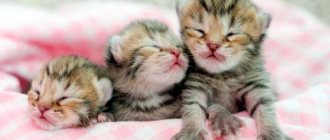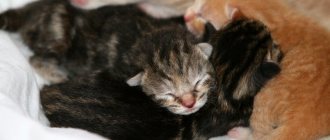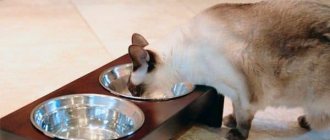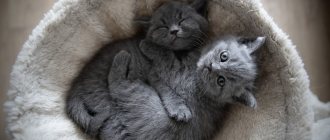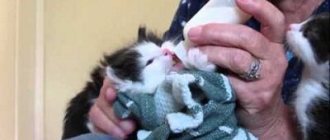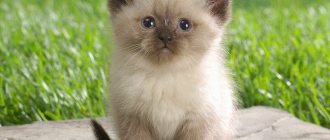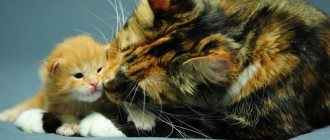What will you learn from the article?
- How to choose powdered milk for kittens - recommendations
- Beaphar Kitty-Milk - the best milk powder for kittens
- Rating of milk substitutes for kittens - composition, characteristics, price Gimpet fortified milk Cat-Milk with taurine
- Royal Canin Babycat Milk
- Nutri-Vet Kitten Milk
- Kittenmilch CDVet
It is an indisputable fact that there is no natural alternative to cat milk. But what to do if for some reason the cat cannot feed her offspring on her own or the kittens are suddenly left without a mother? In such emergency cases, industrial cat milk substitutes come to the aid of owners. Read on to find out which one you should choose.
How to choose powdered milk for kittens - recommendations
Although cat milk replacers are a universal product suitable for all cat breeds, there are a few key points to pay attention to when choosing milk powder:
- Based on the size of the “orphaned” kitten and its belonging to a certain breed. Maine Coon, Savannah, Pixie Bob or Kuril Bobtail kittens need more nutrients to thrive.
- Pay attention to the manufacturer of the dry mixture. Not all manufacturers strictly adhere to the exact proportions of nutrients contained in natural cat milk.
- Study the composition carefully. A high-quality formula for feeding kittens should contain not only proteins, fats and lactose, but also vitamins, minerals, trace elements, taurine, Omega-3 and Omega-6 fatty acids. A lack of these substances can lead to developmental pathologies.
- Do not buy mixtures whose fat content is below 8-8.5% and mixtures with starch.
We analyzed the composition of the most famous brands of cat milk substitutes. Today, only three manufacturers produce powdered milk that is as close in composition to natural cat milk as possible. These brands are: Royal Canin, Beafar and Gimpet. Check out our mini-rating to make your choice easier.
What will you need for self-feeding?
To feed a small newborn kitten, you should purchase special equipment:
- A pacifier, but definitely not a baby one . You will need a special one, which can be purchased at a pet store or veterinary pharmacy. But the baby is fed without a pacifier; it will be needed a little later.
- Pipette . This is the best option for feeding the animal. Its convenience is that food can be served in doses and the volume can be clearly calculated. However, the pipette should be used carefully, since air entering it can cause severe bloating in the baby.
- Spoon - theoretically, a kitten can be taught to eat mixture from a spoon, but this method of feeding contributes to the suppression of sucking reflexes.
- Syringe – used without a tip (needle). This device is considered the most convenient and easy to use. The syringe's nose resembles a cat's nipple and helps develop conditioned reflexes.
Bottles. Pet stores sell special feeding bottles. However, they all have standard universal sizes, so they are not suitable for all breeds of kittens. Owners will need to select an individual size:
- When you turn the bottle over, milk flows out. This indicates that the hole diameter is too large. Intensely leaking milk threatens the kitten with choking.
- The milk comes out of the container only after pressing on it - the hole has an insufficient diameter, so the milk comes out with difficulty, because of this the kitten will not be able to suck it. Such inconvenience for the animal will lead to it refusing to eat.
- The ideal hole size is that the milk drips slowly when you lightly press the sides of the bottle.
It is important to immediately select the correct hole diameter for the kitten.
The animal will quickly get used to a certain type of nipple, and replacing it can lead to a complete refusal to eat from the bottle. It is difficult for a person to replace a mother cat for a newborn kitten. But if you put maximum effort and attention into the process, it will turn out very well.
Special feeding tube
This device is used if it is not possible to awaken the baby’s sucking reflex, accordingly, other methods of feeding are impossible, or the animal is too weak to suck on its own.
Using a special tube is the cleanest and most hygienic method of feeding kittens. But using this device requires a certain skill and extreme care. Disadvantages of using a tube:
- There is no way to control the amount of food, which is why the kitten receives too much of it (extremely bad for digestion) or, conversely, not enough.
- If the baby has a well-developed sucking reflex, but cannot satisfy it due to the lack of a pacifier or syringe, he begins to “suck” the fur of another kitten or his own. He does this too intensely, which can lead to serious skin diseases.
Algorithm for using the handset:
- Open your pet's jaw by pressing on it with your fingers. Before inserting the tube into the esophagus, it must be lubricated with a special product, for example, KY jelly.
- Hold the kitten's head straight while pushing the tube down the esophagus. You need to slide across the sky, moving the device along the back wall of the esophagus.
- The tube should be advanced until the mark on the hose is equal to the level of the nose - it has reached the esophagus.
- Connect a syringe with the nutritional mixture to the tube. It is recommended to press the piston slowly and carefully.
How to make a mark? The distance from the animal's nose to the last rib is measured. The mark is needed in order to insert the tube correctly, directly into the stomach.
Risk of improper use of the tube. You cannot use the tube without certain knowledge and skills. When deciding to feed a kitten with a special device, you must consult with a veterinarian who will demonstrate the correct use of this device.
Incorrect technique for using the tube carries the risk of it getting into the respiratory tract. If the kitten squeaks while feeding, it means that the tube has entered the stomach without touching the respiratory organs. Given the difficulty of tube feeding kittens, this method is mostly used by breeders.
Beaphar Kitty-Milk - the best milk powder for kittens
Complete food from the famous manufacturer Beaphar (Netherlands) for artificially fed kittens. Milk formula for kittens contains the necessary protein and fat content. Kitty-Milk is as close as possible to cat's mother's milk in terms of the content of micro- and macroelements. Suitable for kittens from birth to 35 days of age.
Ingredients: milk and whey, fats, oils. The product is enriched with vitamins: A, B1, B2, B6, B12, C, D3. Contains: choline, lysine, pantothenic acid, nicotinamide, calcium, phosphorus, sodium, iron, zinc, manganese, copper, selenium, iodine, magnesium, taurine, Omega-3, Omega-6.
Dosage: 2 scoops of powder (7 g) thoroughly mixed with a whisk in 50 g. warm water. The finished mixture can be stored in the refrigerator for up to 8 hours. When using, heat to 35-40°C.
- Plus: can be used for additional feeding of pregnant and lactating cats.
- Cons: high price.
Price: pack 200 gr. – 665 rub., 500 gr. – 1673 rub. More details about the product
Rating of milk substitutes for kittens - composition, characteristics, price
- Gimpet fortified Cat-Milk with taurine;
- Royal Canin Babycat Milk;
- Nutri-Vet Kitten Milk;
- Kittenmilch CDVet.
Gimpet fortified Cat-Milk with taurine
Vitaminized dry formula from Germany is designed specifically for kittens without mother's milk, pregnant and lactating cats, weak and elderly animals.
The composition is as close as possible to the natural product. It has a balanced composition of proteins and fats: proteins – 35%, fats – 27%. The protein and fat components of the mixture are of animal origin, which fully satisfies the needs of the kitten’s growing body and protects its digestive tract. Taurine – maintains visual acuity and normalizes heart function. Natural arachidonic acid has been added for healthy skin and coat.
Main composition: milk and dairy products, fats and oils, plant components, minerals, milk sugar derivative. The mixture contains vitamins: A, D3, E, B1, B2, B6, K, B12, biotin, nicotinic acid, C, taurine, pantothenic acid, L-carnitine, folic acid. Mineral composition: calcium, copper, zinc, iron, iodine, selenium, manganese.
Recipe: 1 tablespoon of milk powder is mixed with 3 tablespoons of hot water and cooled to room temperature.
- Plus: full composition.
- Disadvantage: you need to additionally purchase a bottle and nipples for feeding.
Price: pack 200 gr. – 609 rub. More details about the product
Royal Canin Babycat Milk
Complete milk replacer for kittens from birth to 2 months from Royal Canin (France). Easily digestible by the kitten's stomach, the high-calorie food provides the growing body with the necessary nutrients and energy. Kittens fed on this food give a stable weight gain of up to 10 grams. in a day. Milk proteins, lactose and fructooligosaccharides provide digestive tract protection. Protein content – 33%, fat – 39%.
Main composition: milk proteins, animal fats, whey, coconut oil, soybean oil, fish oil, fructooligosaccharides, minerals, aromatic additives.
Vitamin and mineral composition: acids EPA and DHA, Omega-3, Omega-6, arachidonic acid, linoleic acid, calcium, sodium, phosphorus, potassium, manganese, zinc, iodine, selenium, copper, iron, A, E, C, D3, B1, B6, B2, B5, B12, biotin, choline, taurine. Dilute according to the instructions using a measuring spoon and the included bottle.
- Plus: the set includes a measuring spoon, a bottle and nipples with holes of different sizes.
- Cons: Contains fragrances.
Price: pack 300 gr. – 1110 rub. More details about the product
Nutri-Vet Kitten Milk
The dry fortified product from an American manufacturer is fully adapted to the needs of newborn kittens and pregnant cats. Can be used as a source of additional nutrition for lactating animals and elderly individuals. Milk is completely absorbed by the kitten’s body and contributes to its normal development. Protein content – 42%, fat – 25%.
Ingredients: vegetable oil, whey protein, skimmed milk powder, egg yolk, milk fat. Contains vitamin-mineral complex and biotin.
Recommendations for use: stir 1 part dry mixture in 2 parts warm water.
- Plus: the finished mixture can be stored in the refrigerator for up to 24 hours.
- Minus: sold only in online stores.
Price: pack 170 gr. – 863 rub. More details about the product
Kittenmilch CDVet
Milk replacer for kittens with colostrum is an absolutely natural product for feeding feline offspring. Can be used for milk deficiency in a nursing cat with large offspring.
Product composition: whole milk powder, colostrum, milk protein, sodium chloride, locust bean gum. Protein content – 29.42%, fat – 22.62%.
Recommendations for preparation: dilute 1 part of dry powder in 3 parts of hot water and cool to a temperature of 35-40°C.
- Plus: does not contain synthetic additives.
- Cons: high price.
Price: packaging 90 g. – 1145 rub., 750 gr. – 4419 rub. More details about the product
Sterilization and hygiene
Pacifiers, syringes, bottles and other feeding devices should always be sterilely clean. After each feeding, the syringe or pipette, pacifier, milk container must be properly processed. Rinsing with hot water is not enough to clean dishes.
The ideal option is to use a special steam sterilizer. It is sold in pharmacies in children's products. You can use pharmacy sterilizing liquids. After using them, the dishes must be rinsed under warm water. The use of dishwashing detergents is strictly prohibited.
Also watch the video on how to feed a newborn kitten without a cat:
Artificial feeding of kittens - instructions for use
If you have the important task of replacing a kitten’s mother and feeding the baby, you need to adhere to the following rules:
- The dry mixture is diluted immediately before feeding with boiled water, but not boiling water. It must be diluted in the ratio indicated on the product packaging.
- Feeding utensils should be sterile and hands should be washed clean. This will help protect your baby from bacteria and viruses.
- Do not buy large packages of powdered milk, as they may contain pathogenic bacteria during long-term storage.
- Do not store the finished formula that remains after feeding, but throw it away. Even if the manufacturer indicates that the mixture can be stored in the refrigerator. Do not experiment on the health of your kittens.
- For feeding, purchase special nipples and bottles if they are not included with the formula. Feeding from a syringe and spoon is not only inconvenient, but also dangerous - the baby may choke.
Prohibited Products
It is recommended to feed the kitten only with approved products; you cannot experiment. It is strictly forbidden to give your baby:
- Undiluted cow's milk . It is very heavy and difficult to digest, especially by the unformed digestive tract of a newborn kitten. Feeding your pet cow's milk will lead to severe indigestion, from which he may die.
- Cream is an extremely harmful product for a kitten’s digestive system and overall health.
- High fat dairy products . The higher the percentage of fat content in a product, the greater the impact on the liver and the risk of developing indigestion.
- Premature feeding with meat and sausages . The kitten, of course, will like the smell and taste of meat, but its gastrointestinal tract is not able to digest heavy food. The consequences of such complementary feeding can be extremely disastrous.
If you have to independently feed a kitten deprived of its mother cat, it is best to consult a veterinarian.
Customer Reviews
Christina: “The children brought a stray kitten from the street. He was at most a week or two old. He couldn’t eat adult food, so he had to buy cat milk replacer from Royal Canin. I liked that the kit comes with a bottle and nipples with different nipple diameters. The problem was solved in an instant."
Diana: “We had a huge tragedy - our beautiful cat died during childbirth. I felt incredibly sorry for the cat, but she was left with three adorable kittens. Something had to be decided urgently. We could not find a familiar nursing cat. At that moment, we didn’t care how much powdered milk cost - we were very afraid for the lives of the kittens. We bought Jimpet milk powder for kittens at a veterinary pharmacy. Of course, we suffered a lot with feeding, but we were able to save the offspring.”
Vadim: “I didn’t think that I would turn into a mother for a kitten, but I had to. My cat got mastitis and stopped feeding her baby. I had to do this. I bought Beaphar Kitty-Milk, a pacifier and a bottle and played the role of mother for two weeks until the kitten was able to eat adult food.”
How harmful is milk for adult cats?
Should I feed adult cats milk or not? The owner pours nutritious liquid into the bowl without thinking about the consequences. Because there is a myth that all cats love milk and cannot live without it.
The overwhelming majority of experts believe that milk should not be given to adults. This is due to the fact that at a younger age (up to 3 months) kittens have enzymes in their stomachs that allow them to break down dairy products. As we grow older, there are fewer enzymes, and eventually there are none left at all.
The cat family living in the wild does not drink dairy drinks. Therefore, a cat drinking milk is not normal in most cases (there are exceptions). The cat drinks milk and is everything fine? This means that the drink does neither good nor harm, and is simply a delicacy.
Conclusion: Milk is unhealthy for adult cats. Especially if your pet develops diarrhea or vomiting after a “snack”; in other cases, an allergy may develop.
Take a closer look at your pet - the cat will not drink something that can harm it, and especially do not force it to try this drink. If the fluffy has a desire, but the consequences of consumption are bad, the solution would be to offer fermented milk products.
An important point is that giving food and milk at the same time is very harmful - this can result in the development of urolithiasis and harm other organs. Offer only water along with dry food.
